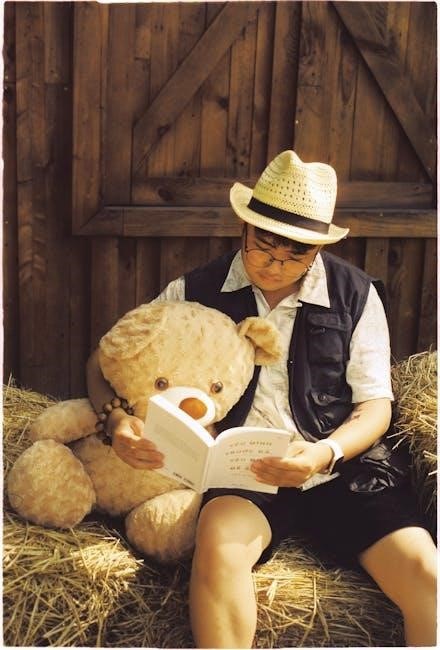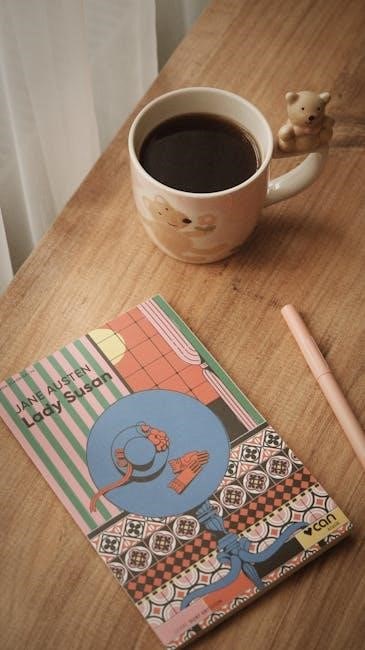Discover the beloved tale of Goldilocks and the Three Bears, a story of curiosity and consequence. Available in PDF, this classic fairy tale continues to captivate readers of all ages with its timeless lessons and engaging narrative, featuring iconic moments like tasting porridge and breaking chairs.
Overview of “Goldilocks and the Three Bears”
Goldilocks and the Three Bears is a classic fairy tale about a curious girl who ventures into the home of a bear family. The story follows Goldilocks as she samples their porridge, sits in their chairs, and sleeps in their beds, leading to a surprising encounter. This timeless narrative explores themes of curiosity, boundaries, and forgiveness. Available in PDF format, the story is easily accessible for readers of all ages, offering a charming blend of adventure and moral lessons, accompanied by vivid illustrations that bring the characters to life.
Why the Story Remains Popular
The tale of Goldilocks and the Three Bears endures due to its universal themes of curiosity, consequences, and forgiveness. Its simple yet engaging narrative makes it accessible to all ages. The story’s moral lessons, such as respecting others’ property, resonate deeply. The relatable characters—Goldilocks’ mischief and the bears’ kindness—create a charming dynamic. Its timeless appeal is further enhanced by its availability in PDF format, making it easy to share and enjoy across generations. This blend of entertainment and ethical teachings ensures its lasting popularity.

Main Characters in the Story
The story features Goldilocks, a curious girl, and the Three Bears: Papa Bear, Mama Bear, and Baby Bear, each with distinct personalities that drive the narrative forward.
Goldilocks: The Curious Girl
Goldilocks is a curious and adventurous girl with a knack for exploring. Her impulsiveness often leads her into trouble, as seen when she enters the bears’ house. With her golden locks and charming demeanor, she captivates readers. Her actions, though misguided, stem from curiosity rather than malice, making her a relatable character. Despite her flaws, Goldilocks’ story serves as a lesson, showcasing the consequences of her decisions while maintaining her endearing qualities.
The Three Bears: Papa Bear, Mama Bear, and Baby Bear
The three bears—Papa Bear, Mama Bear, and Baby Bear—are a loving family living in a cozy house in the forest. Papa Bear is strong and protective, Mama Bear is kind and nurturing, and Baby Bear is playful and innocent. Their routine of porridge and morning walks sets the stage for their encounter with Goldilocks. The bears’ unity and love for each other highlight the story’s themes of family and harmony, making them relatable and endearing to readers of all ages.
Personality Traits of Each Character
Goldilocks is curious and impulsive, often acting without thinking. Papa Bear is protective and patient, while Mama Bear is kind and nurturing. Baby Bear is playful and innocent, embodying youthful energy. These distinct traits create a dynamic family structure, showcasing how each bear reacts differently to Goldilocks’ intrusion. Their personalities highlight themes of curiosity, forgiveness, and family unity, making the story engaging and relatable for readers of all ages.

The Storyline of “Goldilocks and the Three Bears”
The story follows the Bears’ morning walk, Goldilocks’ discovery of their house, her tasting of porridge, sitting in chairs, and sleeping in Baby Bear’s bed.
The Bears’ Morning Walk
The story begins with Papa Bear, Mama Bear, and Baby Bear deciding to go for a morning walk while their porridge cools. On a sunny day, they stroll through the forest, enjoying the fresh air and peaceful surroundings. Their walk allows Goldilocks to discover their house, setting the stage for her curious adventures. The Bears’ absence provides the perfect opportunity for the tale’s central events to unfold. This simple yet pivotal moment highlights the Bears’ harmonious family life before Goldilocks’ arrival. The walk serves as a calm prelude to the story’s lively antics.
Goldilocks’ Discovery of the Bears’ House
While wandering through the forest, Goldilocks stumbles upon the Bears’ cozy cottage. Curiosity piqued, she approaches the house and peers through the windows. Noticing the empty rooms, she decides to investigate further. Finding the door unlocked, she lets herself in, unaware of the Bears’ absence. Her discovery sets the stage for a series of curious and mischievous actions. The house’s inviting appearance draws her in, leading to the story’s central events. This moment marks the beginning of Goldilocks’ adventure, driven by her inquisitive nature and impulse.
Tasting the Porridge: Too Hot, Too Cold, Just Right
Goldilocks, curious and hungry, discovers the Bears’ porridge on the table. She tastes Papa Bear’s porridge, finding it too hot, then Mama Bear’s, which is too cold. Finally, she tries Baby Bear’s porridge, declaring it just right and eats it all. This moment highlights her impulsive nature and sets off a chain of events as she continues exploring the house. The porridge tasting is a memorable scene, showcasing her curiosity and the Bears’ eventual surprise upon returning home.
Sitting in the Chairs: Breaking Baby Bear’s Chair
After tasting the porridge, Goldilocks decides to rest and sits in the Bears’ chairs. She finds Papa Bear’s chair too hard and Mama Bear’s too soft. Finally, she sits in Baby Bear’s chair, which she declares just right. However, the small chair breaks under her weight. This act of carelessness leads to clear evidence of her presence, adding tension to the story. The broken chair becomes a pivotal moment, highlighting her recklessness and setting the stage for the Bears’ return.
Sleeping in the Beds: Goldilocks Meets the Bears
After breaking Baby Bear’s chair, Goldilocks ventures upstairs and finds the beds. She deems Papa Bear’s bed too hard and Mama Bear’s too soft, but Baby Bear’s bed is just right. Exhausted, she falls asleep. When the Bears return, they are shocked to find a girl in Baby Bear’s bed. This confrontation is a turning point, as Goldilocks flees, leaving the Bears to reflect on the day’s events. This moment highlights both fear and resolution, making it a memorable conclusion to her adventure and the Bears’ day.

Moral Lessons from the Story
The story teaches essential life lessons, such as respecting others’ property, facing consequences of impulsive actions, and understanding the power of forgiveness and moving forward.
Importance of Respect for Others’ Property
The story emphasizes the significance of respecting others’ belongings. Goldilocks’ unauthorized entry into the bears’ home and her actions of tasting their porridge, sitting in their chairs, and sleeping in their beds illustrate the consequences of disrespecting property. Her curiosity leads to trouble, teaching children that taking something without permission can harm others and oneself. This lesson highlights the value of boundaries and the importance of asking before using someone else’s things, fostering responsibility and consideration in young readers.
Consequences of Curiosity and Impulsiveness
Goldilocks’ tale underscores the dangers of unchecked curiosity and impulsive behavior. Her decision to enter the bears’ home without permission leads to a series of troublesome events. Tasting the porridge, breaking Baby Bear’s chair, and sleeping in his bed demonstrate how impulsive actions can result in chaos. The story teaches children the importance of self-control and thinking before acting, while also showing how curiosity, when unguided, can lead to unintended consequences. This lesson remains a timeless warning in the PDF version of the story.
Value of Forgiveness and Moving Forward
The story highlights the importance of forgiveness and moving forward after mistakes. Despite Goldilocks’ intrusion and the chaos she causes, the bears choose not to punish her harshly. Instead, they let her go, showing mercy and understanding. This teaches children the value of letting go of anger and resolving conflicts peacefully. The PDF version of the book emphasizes this moral, encouraging readers to embrace forgiveness as a path to healing and harmony, even in difficult situations.

PDF Versions of the Book
The Goldilocks and the Three Bears PDF is widely available online, offering a convenient reading experience. It features vibrant illustrations and interactive elements, making it ideal for children and educators alike.
Where to Find “Goldilocks and the Three Bears” in PDF Format
The PDF version of Goldilocks and the Three Bears can be easily found on platforms like Google Books, Project Gutenberg, and ManyBooks. These websites offer free access to classic tales, including this story. Additionally, official bookstores such as Amazon and Barnes & Noble provide downloadable versions, both free and paid. Simply search for “Goldilocks and the Three Bears book PDF” to explore these options. Ensure to download from trusted sources to avoid any security risks and enjoy high-quality versions of the story.
Features of the PDF Version
The PDF version of Goldilocks and the Three Bears offers a clean and readable format, perfect for digital devices. It often includes colorful illustrations, enhancing the storytelling experience. The text is crisp and adjustable, ensuring readability on various screens. Many PDFs are interactive, with features like zoom, bookmarks, and clickable tables of contents. Some versions include animations or sound effects, making the story engaging for children. The portable format allows easy access on tablets, e-readers, and smartphones, making it ideal for on-the-go reading.
Why Choose the PDF Format for This Story
Choosing the PDF format for Goldilocks and the Three Bears ensures a seamless reading experience. PDFs preserve the story’s original layout, including illustrations and text formatting. They are easily accessible on multiple devices, such as tablets, smartphones, and e-readers. The format allows for zooming in on details, making it ideal for children to enjoy the visuals. Additionally, PDFs are shareable and can be stored conveniently, offering a practical way to enjoy the classic tale anywhere, anytime, while maintaining its charm and educational value for readers of all ages.

Illustrations in the Book
The vibrant illustrations in the PDF version of Goldilocks and the Three Bears bring the story to life, captivating young readers with charming visuals that aid understanding and make the tale memorable and engaging.
Role of Visuals in Enhancing the Story
Illustrations in the PDF version of Goldilocks and the Three Bears play a vital role in engaging young readers. They bring the story to life, making characters like Goldilocks, Papa Bear, and Baby Bear relatable and memorable. Visuals help children understand complex emotions and plot points, such as Goldilocks’ curiosity or the bears’ surprise upon returning home. The vibrant images also enhance the storytelling experience, making it more interactive and immersive. They allow readers to connect with the narrative on a deeper level, fostering imagination and comprehension, especially for early learners who may rely heavily on visuals to grasp the tale.
Notable Illustrators of “Goldilocks and the Three Bears”
Several illustrators have famously brought Goldilocks and the Three Bears to life through their art. Jessie Willcox Smith, a renowned American illustrator, created charming watercolor images that captured the story’s warmth. Arthur Rackham, known for his whimsical style, also contributed iconic illustrations. In the PDF versions, these visuals are preserved, enhancing the storytelling experience. Modern illustrators like Christian Birmingham and Emma Chichester Clark have added fresh perspectives, blending traditional and contemporary styles. Their work ensures the tale remains visually captivating for new generations of readers.
How Illustrations Help Children Understand the Story
Illustrations in Goldilocks and the Three Bears play a vital role in helping children grasp the narrative. They break down complex scenes into visual elements, making the story more accessible. Images of Goldilocks tasting porridge or sitting in chairs clarify her actions, while depictions of the bears’ reactions convey emotions like surprise and frustration. The visuals also highlight key plot points, such as the broken chair or the cozy beds, ensuring children follow the story effortlessly. This visual storytelling enhances comprehension and engagement, making the tale memorable and enjoyable for young readers.

Adaptations and Variations
The story has been adapted into films, stage plays, and modern retellings, offering fresh twists while retaining its core themes of curiosity and consequences.
Different Cultural Adaptations of the Story
The tale of “Goldilocks and the Three Bears” has been reimagined across cultures, with variations reflecting local traditions. In some versions, the bears are replaced with pandas or other animals, while Goldilocks’ character remains a curious intruder. Japanese adaptations often feature a girl named “Kinchaku” who encounters raccoon dogs. Indian versions might include tigers or monkeys, blending the story with folklore. These cultural twists maintain the story’s moral lessons while offering fresh perspectives, making it relatable to diverse audiences worldwide. The PDF format allows these adaptations to be easily shared and enjoyed globally.
Modern Retellings of “Goldilocks and the Three Bears”
Modern retellings of the classic tale offer fresh twists, such as urban settings or the bears as a family of professionals. In some versions, Goldilocks is portrayed as a curious city girl exploring a high-tech house. Others feature the bears as scientists or artists, adding unique dimensions to the story. Digital adaptations, including PDFs, often incorporate vibrant illustrations and interactive elements. These retellings maintain the core moral lessons while appealing to contemporary audiences, making the story timeless and engaging for new generations. The PDF format ensures these modern versions are easily accessible and shareable.
Alternative Endings to the Classic Tale
Alternative endings to “Goldilocks and the Three Bears” offer creative twists, such as Goldilocks apologizing and helping the bears rebuild their home. In some versions, she faces consequences like community service or learning valuable lessons. Others feature humorous endings, such as Goldilocks becoming the bears’ friend or starting a porridge-tasting business. These endings, often included in PDF adaptations, provide diverse perspectives and moral outcomes, keeping the story engaging while maintaining its timeless appeal. Digital formats allow readers to explore these variations easily, enriching the storytelling experience.

Language and Accessibility
The “Goldilocks and the Three Bears” PDF is available in multiple languages, ensuring global accessibility. Digital versions often include text-to-speech and adjustable font sizes, aiding visually impaired readers.
Translations of the Book into Other Languages
“Goldilocks and the Three Bears” is widely translated into languages like Spanish, French, German, Italian, and Mandarin. These translations ensure the story reaches global audiences, preserving its timeless appeal. The PDF format facilitates easy distribution across linguistic and cultural boundaries. Translations maintain the original story’s charm while adapting to regional dialects and nuances. This accessibility helps children and adults worldwide enjoy the tale, fostering a universal understanding of its moral lessons and engaging narrative. The availability of translated PDFs makes the story a valuable resource for language learners and diverse communities.
Accessibility Features in Digital Versions
Digital versions of “Goldilocks and the Three Bears” often include accessibility features like text-to-speech, adjustable font sizes, and high-contrast modes. These tools make the story more inclusive for readers with visual impairments or dyslexia. Some PDFs also support screen readers, ensuring accessibility for visually impaired audiences. Interactive elements, such as clickable illustrations, enhance engagement for children with learning disabilities. These features ensure the story is accessible to a diverse range of readers, promoting inclusivity and equal access to the tale’s timeless lessons and entertainment.
How the Story is Taught in Schools
“Goldilocks and the Three Bears” is widely used in schools to teach literacy and moral lessons. Educators often incorporate the story into reading comprehension exercises, using its relatable characters and simple narrative to engage young learners. Teachers also use it to discuss themes like respect, boundaries, and consequences. Interactive activities, such as role-playing or sequencing events, help students develop critical thinking and storytelling skills. The story’s universal appeal makes it a valuable tool in diverse educational settings, fostering both academic and social development in children.

The Author and Illustrator
The original author of “Goldilocks and the Three Bears” remains unknown, as it is a traditional fairy tale. Illustrators like Jessie Willcox Smith have brought the story to life with their artwork, enhancing its appeal for readers of all ages.
Origins of the Fairy Tale
“Goldilocks and the Three Bears” is a traditional European folk tale with unclear origins. The story first appeared in print in 1837, published anonymously in a collection of fairy tales. Robert Southey is often credited with popularizing it in 1837, though earlier oral versions likely existed. The tale has since evolved through various adaptations, becoming a beloved children’s story worldwide. Its enduring appeal lies in its simple yet engaging narrative, making it a timeless classic in children’s literature.
Contributions of Notable Authors and Illustrators
Several authors and illustrators have contributed to the enduring popularity of “Goldilocks and the Three Bears.” Robert Southey is often credited with the first published version in 1837, while later adaptations by authors like Joseph Cundall and Eleanor Farjeon refined the narrative. Illustrators such as Jessie Willcox Smith and Arthur Rackham brought the story to life with iconic visuals. Modern adaptations by James Marshall and Jan Brett have introduced fresh perspectives, ensuring the tale remains vibrant. Their contributions have shaped the story into a beloved classic, accessible to readers of all ages.
Evolution of the Story Over Time
The story of “Goldilocks and the Three Bears” has evolved significantly since its origins as a traditional oral tale. First published in 1837 by Robert Southey, it has undergone numerous adaptations, with variations in characters and plot. The story transitioned from a darker tone to a more child-friendly narrative, emphasizing moral lessons. Cultural adaptations and modern retellings have further enriched its appeal. The digital age has introduced PDF versions, making the story accessible worldwide. These changes ensure the tale remains relevant, engaging new generations with its timeless themes.

Interactive and Digital Versions
Digital versions of “Goldilocks and the Three Bears” bring the story to life with animations, interactive elements, and multimedia, enhancing engagement and accessibility across devices for modern readers.
Flip PDFs and Interactive Storytelling
Flip PDFs of “Goldilocks and the Three Bears” offer an immersive reading experience with animations, sound effects, and clickable elements. These interactive features bring the story to life, engaging young readers. Children can interact with characters, explore scenes, and participate in quizzes or puzzles related to the tale. Such digital enhancements make storytelling dynamic and educational, fostering a deeper connection to the narrative while keeping children entertained and focused. This format bridges traditional storytelling with modern technology, ensuring the story remains captivating for new generations.
Apps and E-books Featuring the Story
Apps and e-books of “Goldilocks and the Three Bears” are widely available, offering convenient and engaging ways to enjoy the story. Many apps feature interactive elements, such as animations, voice narration, and touch-to-read options. E-books provide portable access, with some including puzzles, quizzes, or games to enhance learning. These digital formats cater to modern readers, making the story accessible on tablets, smartphones, and e-readers. They also offer customizable settings, like font size and night mode, ensuring a comfortable reading experience for children and adults alike.
Enhanced Reading Experiences with Multimedia
Multimedia features in digital versions of “Goldilocks and the Three Bears” create immersive reading experiences. Animations, sound effects, and voice narration bring the story to life, engaging young readers. Interactive elements like puzzles and quizzes enhance understanding and retention. Background music and character voices add depth, while visual effects like moving characters and changing scenes captivate audiences. These features make the story more dynamic and memorable, catering to diverse learning styles and preferences for a richer storytelling experience.
Why Read “Goldilocks and the Three Bears”
This classic tale offers timeless lessons, sparking imagination in children while evoking nostalgia in adults. Its universal themes of curiosity, consequences, and forgiveness resonate across generations, making it a cherished read for all ages.
Benefits for Children’s Development
Reading “Goldilocks and the Three Bears” aids in children’s cognitive and emotional growth. It enhances language skills through engaging storytelling and repetitive phrases, improving memory and comprehension. The tale teaches moral lessons about respect, consequences, and forgiveness, shaping ethical understanding. Additionally, it fosters empathy and social skills by introducing relatable characters and situations. The story’s simplicity and visual appeal make it an excellent tool for early literacy development, encouraging a lifelong love for reading while promoting critical thinking and creativity in young minds.
Appeal to Adults and Nostalgia
The timeless charm of “Goldilocks and the Three Bears” captivates adults with its nostalgic appeal. Many remember the story from their childhood, evoking fond memories of bedtime readings and family bonding. The tale’s simplicity and universal themes, such as morality and humor, resonate with adults seeking comfort or revisiting cherished moments. The PDF format allows easy sharing with children, bridging generations and fostering a sense of continuity. Adults appreciate its enduring relevance, making it a delightful read for both kids and those young at heart.
Universal Themes and Messages
“Goldilocks and the Three Bears” conveys timeless themes that resonate universally. The story highlights the importance of respect for others’ property, consequences of curiosity, and the value of forgiveness. It teaches children about boundaries and responsibility while offering adults a reminder of life’s simple moral lessons. The tale’s themes of cause and effect, patience, and understanding are relevant across cultures, making it a story that transcends age and generations, ensuring its enduring appeal and educational value.
The PDF version of “Goldilocks and the Three Bears” offers a convenient and engaging way to enjoy this timeless tale. Its universal appeal makes it ideal for both children and adults, ensuring its legacy endures through modern formats. Reading the story in PDF format allows for easy access and sharing, keeping the classic alive for future generations to cherish and learn from its valuable lessons.
Final Thoughts on the Story’s Impact
“Goldilocks and the Three Bears” remains a timeless tale, captivating readers with its simple yet profound lessons. Its adaptability across cultures and ages highlights its universal appeal. The story’s moral teachings on respect, consequences, and forgiveness continue to resonate deeply. Available in PDF, it ensures accessibility for modern readers, preserving its legacy. Its enduring popularity underscores its ability to connect with audiences, making it a cherished story for generations. The PDF format enhances its reach, ensuring its impact endures in the digital age.
Encouragement to Read or Download the PDF
Embark on a delightful journey with “Goldilocks and the Three Bears” in PDF. This convenient format makes the story accessible anytime, anywhere, perfect for reading on the go. The PDF preserves the timeless charm of the tale, ensuring its lessons on curiosity and respect reach new generations. Ideal for children, it sparks imagination and teaches moral values. Parents and educators will find it a valuable resource. Download now and share the magic with your little ones, keeping the story alive for years to come.
Future of the Story in Digital Formats
The digital evolution of “Goldilocks and the Three Bears” ensures its enduring appeal. Interactive PDFs and e-books now offer features like animations and voice narration, making the story more engaging. Enhanced multimedia elements, such as sound effects and clickable illustrations, immerse readers in the tale. With eco-friendly and space-saving benefits, digital formats are ideal for modern readers. As technology advances, the story will likely incorporate augmented reality and personalized learning tools, ensuring its relevance for future generations while preserving its timeless charm and moral lessons.
